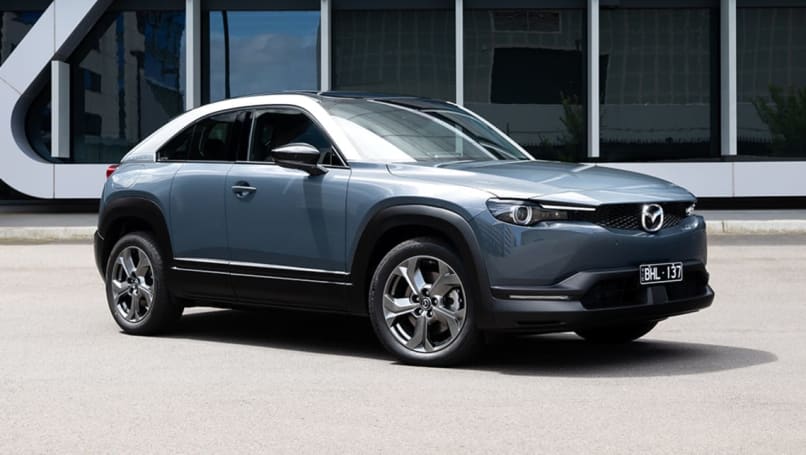
Can Kia topple Mazda in 2025? How the Kia Tasman ute, EV5 electric car and next-gen Mazda CX-5 could shape the sales charts in Australia this year
Kia set a sales record in Australia last year and the company’s boss...
Browse over 9,000 car reviews

It was only last December that we asked if Mazda Australia had hit peak SUV with the electrified MX-30 (small), but now the question needs to be raised again following the confirmation of the all-new CX-60 (mid-size) – and the possibility of three other new models.
In case you missed it, Mazda announced five new global SUV models earlier in October. Yep, that was the same Mazda that already had seven in its international line-up.
Of course, the MX-30 added to the CX-3 (light), CX-30 (small), CX-4 (mid-size), CX-5 (mid-size), CX-8 (large) and CX-9 (large) when it arrived, but now the CX-60 is entering the fold alongside the CX-50 (mid-size), CX-70 (mid-size), CX-80 (large) and CX-90 (large).
Confused? Undoubtedly, there’s a lot to digest there, but by in the next two years, Mazda will have five SUVs in the global mid-size segment and four in the large, plus one in the light and two in the small.
That said, we don’t get the Chinese-made CX-4 in Australia, and the US-focused CX-50 has already been ruled out for our market, while the CX-70, CX-80 and CX-90 are still being assessed for a local introduction, so time will tell if Mazda’s SUV line-up here grows beyond the CX-60.
However, the smart money is on either the CX-80 or CX-90 – possibly both – being added to Mazda Australia’s SUV line-up. And given the former will have a ‘regular body’ like the CX-60 that’s due locally “before the end of 2022”, it seems the likeliest.
For reference, the two-row CX-70 and three-row CX-90 will have a ‘wide body’ to better appeal to their primary target, North America, while the two-row CX-60 and three-row CX-80 are set for Europe, Japan and other markets with “narrower roads and smaller parking lots”, according to Mazda.
Now, it might seem a little short-sighted to have five mid-size and four large SUVs co-existing in an international line-up, but aside from their different target markets, there is one key difference between these models.

You see, the two-row CX-4, two-row CX-5, three-row CX-8, three-row CX-9 and now two-row CX-50 are mainstream players, while the CX-60, CX-70, CX-80 and CX-90 will push Mazda even further into premium territory.
How? Well, all four models will use Mazda’s all-new ‘large’ architecture, which will support rear-wheel drive (RWD) and all-wheel drive (AWD) configurations – you know, like those offered by Mercedes-Benz, BMW and other established premium brands.
Better yet, the CX-60, CX-70, CX-80 and CX-90 will represent the next big step in Mazda’s electrification plans, with their optional plug-in hybrid (PHEV) powertrain set to combine a petrol four-cylinder engine with an electric motor.
But the news that’s set enthusiasts’ tongues wagging is the quartet’s available turbocharged SkyActiv-X petrol and SkyActiv-D diesel inline six-cylinder engines with 48V mild-hybrid systems – that’s two more cylinders than the CX-4, CX-5, CX-8 and CX-9 currently offer.

Yep, Mazda is getting serious about performance again, with the CX-60, CX-70, CX-80 and CX-90 shaping up as its most powerful models since… well, ever – the RX-7 Type R’s 206kW isn’t exactly a high benchmark, after all.
Point being, Mazda will soon have multiple mainstream and premium SUVs in the mid-size and large segments, ensuring it appeals to even more buyers than before.
We’ll see how far Mazda takes its premium push, particularly in Australia, where the CX-60 should find itself at the more affordable end of the class, closer the Lexus NX (from $57,500 plus on-road costs) and Genesis GV70 ($66,400), as well as the similarly named Volvo XC60 ($67,990) and others.
Or Mazda Australia could really surprise us and go after the Audi Q5 (from $69,900 plus on-road costs), BMW X3 ($73,900) and Mercedes-Benz GLC ($79,800) with the CX-60, which is, admittedly, already measuring up on paper. But being a new entrant, it has really no choice but to undercut Germany’s Big Three.

And then there’s the potential local case of the CX-80/CX-90, which would put the pressure on the Lexus RX (from $73,013 plus on-road costs), Volvo XC90 ($86,990) and Genesis GV80 ($90,476) as well as the BMW X5 ($104,400), Audi Q7 ($105,100) and Mercedes-Benz GLE ($118,700), among other models.
And given Mazda Australia always has its hand up for any and all new models, the possibility of the CX-70 joining the CX-60 here, too, cannot be understated.
After all, the Japanese brand’s local managing director, Vinesh Bhindi, told CarsGuide last December that “if Mazda Corporation designs and brings to market an SUV for somewhere else, we will consider, ‘Why can’t we make this work?’”
Stay tuned, because Mazda Australia will soon have seven – maybe even 10 – SUVs in its model line-up. The power of choice, hey?
Comments